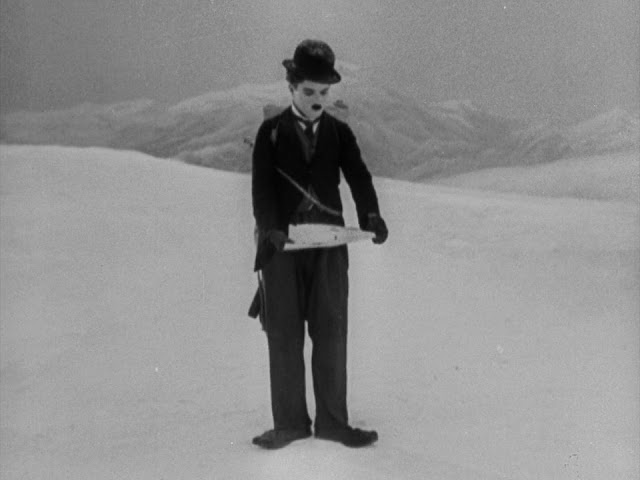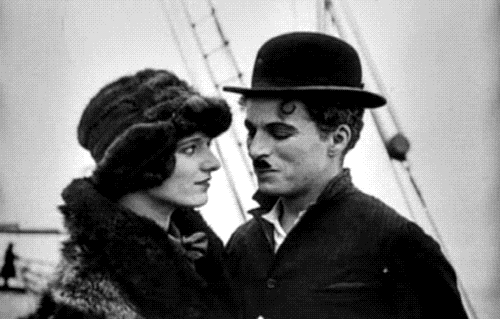Date Seen: 6/12/17
Score: 4/5
DIRECTOR: Charlie Chaplin
PRODUCER: Charlie Chaplin
STUDIO: United Artists
SCREENPLAY: Charlie Chaplin
CINEMATOGRAPHY: Roland Totheroh
 |
| Chaplin the chicken |
 |
| Tom Murray |
 |
| Georgia Hale and Malcolm Waite |
 |
| Chaplin turns food into shoes, a juxtaposition between the earlier feast scene, during which he turns shoes into food. |
 |
| Georgia Hale and Charlie Chaplin |
Charlie Chaplin said that if there was one film he hoped to be known for, it was 1925's The Gold Rush. This is a pretty monumental claim, especially coming from Charlie Chaplin, who created so many wonderful, iconic, brilliant films over his career that it seems unreasonable for him to be known by only one of them. To tell the truth, I was unfamiliar with The Gold Rush until seeing it listed on the AFI 100 Greatest American Films List (a list that I am working my way through, as you may be able to tell from the selections I feature on this blog). This is the third Chaplin film I've seen (after The Kid and The Great Dictator), and while it wasn't my favorite, I enjoyed it very, very much. I should say that there are several versions of this film- it was originally released in 1925 as a silent film, and Chaplin rereleased it in 1942 with a newly recorded voiceover narration, new score, tightening the editing and the speed of the film, and cutting several shots (including the kiss at the end). I watched the original 1925 version, and that is what I will be discussing today.
What makes Chaplin's Little Tramp so endearing is his childlike nature onscreen, the absolute innocence he displays while attempting to take on the harsh world around him. By embodying a tramp, he's rejecting excess and luxury, simplifying his needs to only what will allow him to survive. Chaplin's Tramp famously constructs a heightened juxtaposition between his character and his society, one which, as film historian William Paul has pointed out, is shaped to suit Chaplin's character. The Gold Rush is perhaps one of the finest and sharpest examples of this directional tendency in Chaplin's films. From the moment we see Chaplin's Lone Prospector, an incarnation of the Little Tramp, in the exact same outfit he wears in all of his films, regardless of setting, it is absolutely clear that he is not changing himself to fit the environment; the environment, like the Cabin shifting dramatically under his weight, is changing for- and because of- him. It's funny, of course, that a man would wear a busted-up suit and worn-down city boots, a bowler hat and a cane to go gold prospecting in the Yukon; but more than that, it's telling, both of the Little Tramp's timelessness, and his individual importance in the films.
Critics have called Chaplin an egoist, and that may be true. Regardless of Chaplin's personal intentions, he was always correct in assuming that the point of his Little Tramp films, made relatively early in his career, were to showcase his own character with an unending array of possible settings. While comics such as Buster Keaton and Harold Lloyd preferred the opposite- to play multitudes of characters depending on the setting of the film- Chaplin created the whole Abbott and Costello Meet Frankenstein idea. If that makes him an egoist, it also makes him a genius, because he has enough trust in himself as a director and a performer to understand that the audience wants him.
The Gold Rush is a great film for a variety of reasons. Personally, I was absolutely stunned by its special effects. While certain shots- such as the famous opening seven-shot sequence of gold miners in the Yukon- were filmed on location sets, others were cleverly engineered in studio sets. As several critics, including Paul, point out, this juxtaposition between set and location creates the illusion of safety. We know that the Little Tramp can't perish in the wilderness, because the wilderness is what created him, and his entire shtick is to be beaten down as hard as he can by environmental factors, and to jump right up off his feet again. In a way, by showing Chaplin's Tramp teetering off the edge of what is obviously a studio cliff, all the while being followed by a bear, Chaplin the Director is smugly demonstrating his power to manipulate both the elements of his film and the audience members. Whereas certain environmental hardships in The Kid (1921) are quite reasonable (despite being exaggerated), such as the possibility of an orphan being taken away by the state and the reality of having to scrimp for food and expenses, the hardships in The Gold Rush are completely absurd. There is no way anybody could survive the conditions the Little Tramp is placed into- the possibilities of freezing to death, starving to death, falling off of cliffs, being attacked by wild animals, being attacked by outlaws, catching on fire, and, most obviously, attempting to prospect for gold in the arctic tundra wearing a thin suit and bags for shoes. This, of course, is what makes the film so funny- it's downright hyperbolic.
I was also struck by The Gold Rush as a film about isolation- physical, social, and the works. Obviously Chaplin's Tramp is physically isolated in the wilderness of the Yukon, a "lone prospector" amidst a desert of whiteness, but he's also set apart physically by his dress, mannerisms, and optimism. He is so obviously an outsider in every possible way that it genuinely hurts to see him interact with others. It's also really, really funny. Chaplin plays around with the idea of social isolation in a number of ways, consistently showing the Tramp as more and more outlandish, from his overly-refined table manners to his unmoving, dark back set against a sea of moving, light and merry dancers, to his physical contrast to the other miners, to him being seen as a literal chicken to his hallucinating partner. While some of these moments are hilarious (especially the chicken scene), others are downright poignant.
The plights faced by the Little Tramp in any movie, but especially in The Gold Rush are familiar to viewers in an uncomfortable way, but in a way that powerfully resonates. Many of us know what it feels like to be isolated, to be an outsider, to be manipulated by popular people, to make fools of ourselves. Chaplin has created a character so pure, so childlike, that seeing him face the harsh world creates an emotional, almost parental bond between the character and the viewer. We want him to be okay, and at the bottom of our hearts we understand that he will be, but despite the cringe-worthiness of his experiences, we nonetheless find it in our best interest to laugh.
Sources:
"The Gold Rush (1925)" by William Paul, published in a 1972 edition of Film Comment, vol. 8 no. 3
"Study Guide to The Gold Rush (1925)" by Joseph Mersand, published in a 1975 edition of Literature Film Quarterly, vol. 3 ed. 2
"The Gold Rush," from Wikipedia
All photos were sourced from Pinterest, Google Images, and FilmGrab.com
YOU MAY ALSO LIKE:
































No comments